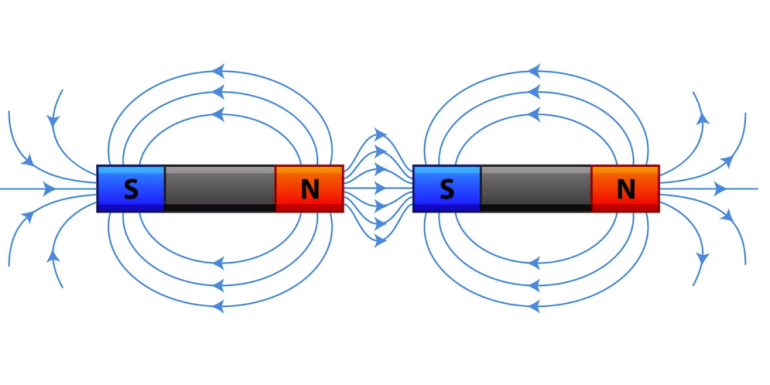
A magnetic field, also called a vector field, is the magnetic influence on moving electric charges, magnetic materials, and electric currents.
Magnetic fields force electrically charged particles to move in a circular or spiral path, and the charged particles exert a force perpendicular to their own velocity and the magnetic field. A magnetic field can be expressed as the area around a magnet where the effect of magnetism is felt.
The magnetic field can be denoted by B or H. Mathematically, it is denoted by quantities known as vectors, which have both direction and magnitude.
Two different vectors help represent a magnetic field: magnetic flux density (or magnetic induction) and magnetic field strength (or magnetic field strength).
The unit of magnetic field is the Tesla and its base unit is the (Newton.Second)/Coulomb. It is known that magnetic field lines do not cross each other. In fact, magnetic lines form closed loops, starting from the north pole and ending at the south pole. The density of the field lines generally indicates the strength of the field.
What is a magnetic field?
- A magnetic field is a field created by the motion of electric charges.
- A magnetic field can be defined as the area around a magnet where the effect of magnetism is felt.
- It is a force field that exerts a force on materials such as iron when placed near it.
- Magnetic fields do not require a medium to propagate; they can even propagate in a vacuum.
- Magnetic field has a greater energy storage capacity than electric field, which distinguishes it from electric field and allows its use in any electromechanical device such as transformers, motors and generators.
Magnetic Field
- A magnetic field is a vector field, usually located near a magnet, electric current, or changing electric field, where magnetic forces are detectable.
- Magnetic field and electric field are generally two interrelated concepts and are essentially part of the electromagnetic force.
Frequently Asked Questions
How do you represent the magnetic field lines of a bar magnet?
In the case of a bar magnet, the field lines rise from the north pole and enter the magnet at the south pole. These lines then penetrate the magnet to the north pole, where they reappear.
History of the Magnetic Field
The magnetic field was first studied in 1269, when the French scholar Petrus Peregrinus de Maricourt used iron needles to map the magnetic field on the surface of a spherical magnet.
He saw that the resulting field lines intersected at two points. These points were called "poles". After this observation, he concluded that no matter how finely a magnet is cut, it always has a north and south pole.
William Gilbert claimed three centuries later that the Earth is a magnet.
According to John Mitchell, an English clergyman and philosopher, magnetic poles attract and repel each other; he came up with this claim in 1750.
Charles-Augustin de Coulomb experimentally verified the Earth's magnetic field in 1785.
Following this, in the nineteenth century, the French mathematician and geometrician Simeon Denis Poisson developed the first model of the magnetic field, which he published in 1824.
In the nineteenth century, new discoveries challenged previously accepted views.
Hans Christian Orsted, a Danish physicist and chemist, discovered in 1819 that an electric current creates a magnetic field around itself.
In 1825, André-Marie Ampère proposed a model of magnetism in which the magnetic force was due to continuously flowing current loops rather than dipoles of magnetic charge.
Faraday, an English scientist, demonstrated in 1831 that a changing magnetic field produces an electric field. He discovered electromagnetic induction.
James Clerk Maxwell published theories on electricity and magnetism between 1861 and 1865. Maxwell's equations were developed. These equations described the interaction of electricity and magnetism in detail.
Illustration of a magnetic field
Typically, a magnetic field can be represented in two ways.
- Magnetic Field Vector
- Magnetic Field Lines
Magnetic field vector
A magnetic field is mathematically described as a vector field. The magnetic field is assumed to have both magnitude and direction. A vector field can be represented as a grid of vectors. The length of the vector is determined by the strength of the magnetic pull.
Magnetic field lines
Magnetic field lines are imaginary lines that surround a magnet. The density of the field lines indicates its size. The magnetic field is strongest around the south and north poles of the magnet and weakens as it moves away from the poles.
Magnetic field lines experiment
Generally, the magnetic field is strongest around the north and south poles, and the strength weakens as you move away from them. The experiment below:
What you need
A sheet of white paper, a bar magnet, iron filings
Experiment
-<! Place a sheet of white paper on the table and place a bar magnet underneath it in the center.
-<! Scatter iron filings around the magnet.
-<! Tap the paper gently.
-<! It can be seen that the iron filings align in a precise pattern that replicates the field of the magnet.
-<! If you look closely at these filings, you will see that the iron filings gather around the magnet most in the area of the poles, but the concentration decreases the farther they are from the poles.
Source:QuantumBoffin
Properties of magnetic field lines
Some of the important properties of magnetic field lines include:
- Magnetic field lines never cross.
- It moves along the path of least resistance between opposite magnetic poles. The magnetic field lines of a bar magnet move in closed loops from one pole to the other.
The magnetic field lines will be the same length.
- The density of power lines decreases as they move from a region of higher permeability to a region of lower permeability.
- The lines move from the South Pole to the North Pole in a material magnetic field, while in the air they flow from the North Pole to the South Pole.
- The magnetic field density varies with distance from the pole. Its density decreases as it moves away from the pole.
How to draw magnetic field lines
- Magnetic lines of force can be drawn using a compass, a bar magnet and a piece of paper.
First, place the paper on the drawing board. Place the bar magnet in the center and mark it with a pencil.
- Keep the compass close to one of the poles of the magnet. Make sure there is no other magnetic material nearby.
- You can see the compass arrow pointing in many directions. Make a dot mark in that direction.
- Remove the compass from this point and place it on the dot so that the base of the arrow is in the dot.
- Make a new dot in the direction the compass arrow is now pointing.
- Repeat this method until the compass hits the opposite pole of the magnet. Connect the dots. Return to the previous position and repeat the process from the new location.
- After drawing a few lines, it is clear that the lines form a closed loop that appears to start at one pole of the magnet and end at the other. This is how magnetic field lines are drawn.
- Magnetic field lines will vary depending on the type of magnets used.
Source: vt.physics
How is a magnetic field created?
A magnetic field can be created not only by a magnet, but also by moving charge or electric currents. We all know that matter is made up of small pieces known as atoms. The nucleus of an atom is made up of protons and neutrons, and electrons orbit around it.
The magnetic field is produced by the rotation and circling of protons and neutrons or the nucleus of an atom. The direction of the magnetic field is determined by the directions of orbit and rotation. The magnetic field is mathematically represented by the letter 'B.' Tesla is the name of its unit (T).
Magnetic field strength
- Magnetic field strength can also be defined as magnetic field strength or magnetic intensity.
- The magnetic field strength can be denoted by the vector H.
- Magnetic field strength can be defined as the ratio required to produce a certain flux density (B) within a particular material per unit length of that material.
- Magnetic field strength can be measured in units of amperes/meter.
The magnetic field strength formula can be represented as:
H = B/μ - M
Where:
B = magnetic flux density
M = magnetization
μ = magnetic permeability
Tesla is a unit of magnetic field strength. One Tesla (1 T) can be expressed as the field strength producing one newton of force per ampere of current per meter of conductor.
How else can a magnetic field be produced?
A magnetic field can develop when a charge is in motion. There are two other ways to arrange the charge so that it is in motion and further generate a useful magnetic field.
1. A magnetic field can be generated whenever an electric charge is in motion.
2. Permanent magnets work by the motion of electrons around nuclei. Only certain materials can be made into magnets, and some are much stronger than others.
Earth's magnetic field
Sir William Gilbert first mapped the Earth's magnetic field in the 1600s. Based on his tests, he found that the Earth has magnetic properties and a magnetic field. If a magnet is hung loosely and allowed to rotate in a horizontal position, it will automatically align and stop in a north-south direction.
The magnet will be aligned so that the north pole is attracted to geographic south and the south pole to geographic north.
Hypothesis on the source of the Earth's magnetic field
1. Earth's core is a hot molten liquid that contains ions. These ions circulate inside the liquid in the form of current loops and create a magnetic field.
2. Earth rotates on its axis and the matter on the planet is made up of charged particles. These charged particles in the form of current loops also rotate around the Earth's axis and are responsible for creating the magnetic field.
3. Ionized gases form the outer layer of the Earth. When the Earth rotates, the movement of ions generates an electric current that results in the creation of a magnetic field.
But you can learn more about Earth's magnetic field in a separate article.
Sources:
Magnetic Field Physics on the UK Faculty of Physics website: https://physics.mff.cuni.cz/kfpp/prednasky/fmp/
Magnetic field articles at Vesmír.cz: https://vesmir.cz/tag/magneticke-pole/
Magnetic field on Wikipedia: https://cs.wikipedia.org/wiki/Magnetick%C3%A9_pole
Online lecture on magnetic field by Michel van Biezen on YouTube: https://www.youtube.com/watch?v=TKTNZBGD22w







